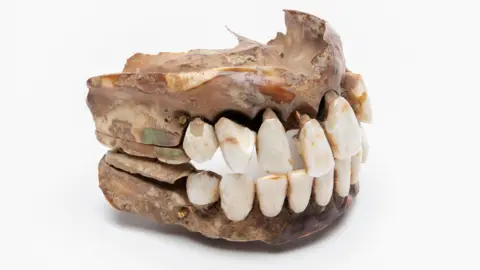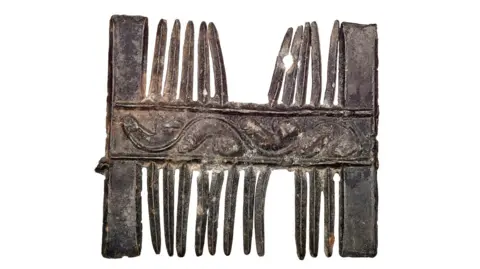'The Thames holds so many of London's secrets'
 London Museum
London MuseumA 16th-century ivory sundial,18th-century false teeth and some medieval spectacles are just some of the items that have been found along the banks of the River Thames by mudlarks in the past 50 years.
Mudlarking was historically a trade of the Victorian poor and has recently become a popular hobby among history lovers.
The items, along with hundreds of others, feature in a new exhibition at the London Museum.
Curator Kate Sumnall said: "One of the key points that I really wanted to convey is that the Thames is a remarkable place, a holder of so many of London's secrets and the past."
 London Museum
London Museum Museum of London
Museum of LondonMs Sumnall said she wanted to "acknowledge the role of mudlarks" and their contribution towards archaeology.
"They're recording their finds and they are making a big difference," she said.
The new exhibition explores finds from the Thames foreshore and the role of mudlarks in uncovering thousands of years of human history.
Early records of mudlarking date back to the mid-1800s when London's poorest communities searched the foreshore for bits of metal, rope and coal to make their living.
Today, licensed mudlarks explore the wet clay banks of the Thames to find preserved historical treasures revealed at low tide.
On average, the London Museum's finds liaison officer records about 700 finds a year and identifies around 5,000, with a small number brought into the museum's collection.
 London Museum
London MuseumMarie-Louise Plum, a mudlarking enthusiast, said: "The Thames is a really liminal zone where the past and the present meet.
"You get this convergence of different periods of time and place," she said.
Ms Sumnall added: "I want visitors to come away with a sense of wonder, of how we can just explore these little moments of London's past."
Additional reporting by PA Media
Listen to the best of BBC Radio London on Sounds and follow BBC London on Facebook, X and Instagram. Send your story ideas to [email protected]
